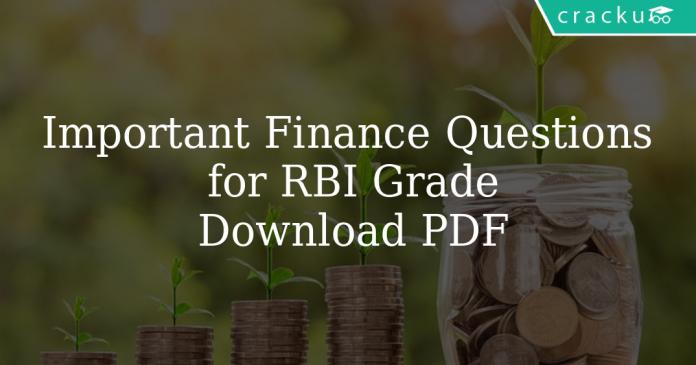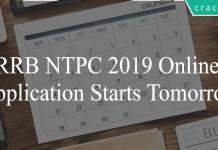Important Finance Questions for RBI Grade-B
Download Very important RBI Grade-B Banking Awareness Questions with solutions PDF. This PDF covers Top-30 Banking Awareness questions and answers for RBI Grade-B exam based on previous year asked questions from RBI and other Banking exams.
Download Important Finance Questions PDF
Take 3 Free Mocks for RBI Grade-B
Download RBI Grade-B Previous Papers PDF
Read this Post in Telugu
Question 1: Which of the following is not one of the various types of Financial Market Infrastructures (FMIs) categorized in the principles of FMIs by Reserve Bank of India?
a) Securities Settlement System
b) Payment Systems
c) Central Counter Parties
d) Trade Repository
e) Special Cell Dealers
Question 2: The Debt Security that doesn’t pay Interest and is issued at a deep discount to its face value is called?
a) YTM Bond
b) Discount Bond
c) Coupon Bond
d) Zero Coupon Bond
e) None of the Above Options
Question 3: Who is the present Director of SFIO-Serious Fraud Investigation Office which is a fraud investigation agency under the Ministry of Corporate Affairs?
a) Rajiv Kumar
b) Amardeep Singh Bhatia
c) Ajay Tyagi
d) T Vijayan
e) Sunil Arora
Question 4: What is the type of Knowledge that is difficult to transfer to another person by merely writing it down or verbalizing it?
a) Explicit Knowledge
b) Tacit Knowledge
c) Anchored Knowledge
d) Implicit Knowledge
e) Systemic Knowledge
Question 5: An employee of a bank collided with an outsider and defrauded the bank by assisting the outsider in pledging fake gold loan, which of the following risk is associated with this issue for the bank?
a) Market Risk
b) Systemic Risk
c) Operational Risk
d) Cash Risk
e) Management Risk
Question 6: Insurance Regulatory Development Authority of India was set up in the year 2000 on the recommendations of which of the following committees?
a) N Narsimhan Committee
b) D R Mehta Committee
c) R N Malhotra Committee
d) Chatalier Committee
e) Dantwala Committee
Question 7: SARFAESI Act, which assists banks and financial institutions in auction properties of default customers in an easy and efficient manner, came into existence in which of the following years?
a) 1998
b) 1994
c) 2012
d) 2002
e) 2006
Question 8: SENSEX is the index of Bombay Stock Exchange which is created on the basis of average price movement of how many stocks listed on BSE?
a) 100 companies/stocks
b) 500 companies/stocks
c) 50 companies/stocks
d) 150 companies/stocks
e) 200 companies/stocks
Question 9: Reserve Bank of India has recently revised the exposure limit under Single Limit for Domestic and Foreign Investors to how much amount in Exchange Traded Currency Derivatives Market recently?
a) USD 35 Million
b) USD 55 Million
c) USD 90 Million
d) USD 100 Million
e) USD 80 Million
Question 10: Negotiated Dealing System – Order Matching is an order driven electronic system launched by Reserve bank of India for trading government securities, NDS – OM is operated by which of the following organizations on behalf of RBI?
a) Fixed Income Money Market and Derivatives Association
b) Financial Benchmark India Pvt Ltd
c) Clearing Corporation of India Ltd
d) National Payments Corporation of India
e) State Bank of India
RBI Grade-B Free Study Material (Download PDF)
Question 11: Which of the following is not one of the type of financial instruments which are traded in the capital markets?
a) Hybrid Instruments
b) Equity Instruments
c) Derivative Instruments
d) Debt Instruments
e) Commercial Instruments
Question 12: Which of the following types of instruments are debentures which are redeemed at a premium over the face value of the debentures?
a) Redeemable Debentures
b) Zero Coupon Debentures
c) Fully Convertible Debentures
d) Floating Rate Debentures
e) Secured Premium Notes
Question 13: Which of the following is not possible in the case of management of a Risk by an Organization?
a) Risk Mitigation
b) Risk Monitoring and Control
c) Risk Pricing
d) Risk Measurement
e) Risk Elimination
Question 14: Which of the following ratios determines the net income generated by the total assets by comparing net income over total assets over a period of time?
a) Return on Investment Ratio
b) Debt Service Coverage Ratio
c) Gearing Ratio
d) Return on Assets Ratio
e) Operating Ratio
Question 15: Credit Rating Agencies in India are regulated by which of the following organizations?
a) Reserve Bank of India
b) Ministry of Corporate Affairs
c) Credit Regulatory Board of India
d) Securities and Exchange Board of India
e) Association of Credited Companies in India
Download RBI Grade-B Previous Papers PDF
Question 16: Chit Fund companies in India are regulated by which of the following organizations?
a) Small Industries Development Bank of India
b) Pension Fund Regulatory Development Authority
c) Reserve Bank of India
d) Respective State Governments
e) Securities and Exchange Board of India
Question 17: The aggregate lending exposure to all borrowers at any Point of time, across all Peer-to-Peer(PtoP) lenders shall be subject to a Cap of how much amount as notified by Reserve Bank of India?
a) Rs 15 Lakhs
b) Rs 25 Lakhs
c) Rs 75 Lakhs
d) Rs 100 Lakhs
e) Rs 10 Lakhs
Question 18: Which of the following is not a non-monetary incentive used by the manager sometimes to build up the morale of the sub-ordinate staff?
a) Job security
b) Promotion Opportunity
c) Bonus Scheme
d) Job enrichment
e) Recognition
Question 19: By the Rule of 72, how long will it take for an investment to double its value, if the interest rate is 7.5%?
a) 15.8 Years
b) 9.6 Years
c) 8 Years
d) 12.2 Year
e) 14 Years
Question 20: Fiscal Responsibility and Budget Management Act has been enacted in which of the following years, which is aimed at incorporate financial discipline, set targets for government of India from time to time to reduce fiscal deficit?
a) 2012
b) 2010
c) 2005
d) 2000
e) 2003
Free Banking Study Material – 18000 Practice Questions
Download Free General Knowledge Questions PDF
Question 21: Which of the following banks/ financial institutions is the largest holder of stake in Small Industries Development Bank of India, a total of 29 institutions hold stake in the bank?
a) State Bank of India
b) General Insurance Corporation of India
c) IDBI Bank
d) MUDRA Bank
e) Life Insurance Corporation of India
Question 22: National Housing Bank was setup in which of the following years under the National Housing Bank act?
a) 1997
b) 1979
c) 1988
d) 1992
e) 1991
Question 23: Which of the following types of funding belongs to Alternate Sources of Finance categorization?
a) Government Bonds
b) Investment in an immovable property
c) Equity Investments
d) Venture Capital
e) None of the above
Question 24: All transactions of International Banking Units set up at IFSC (International Financial Service Centers) Unit shall be in currencies other than which of the following currencies?
a) YUAN
b) USD
c) EURO
d) YEN
e) INR
Question 25: As per the ICDR regulations of SEBI, retail investor is defined as a persons who holds investments upto what amount in a public issue?
a) Rs 10 Lakhs
b) Rs 2 Lakhs
c) Rs 50,000
d) Rs 1 Lakh
e) Rs 5 Lakhs
Question 26: Which of the following is not one of the types of Financial Futures Contracts?
a) Futures on Stock bearing Indices
b) Futures on Interest bearing instruments
c) Futures on Mutual Funds
d) Futures on Currencies
e) Futures on Commodities
Question 27: What does “I” Stand for in FRDI Bill which has been in news recently?
a) Information
b) Insolvency
c) Insurance
d) Investment
e) Industrial
Question 28: Which of the following Organizations are not Insured by DICGC (Deposit Insurance Credit Guarantee Corporation) which is a wholly owned subsidiary of Reserve Bank of India?
a) Local Area Banks
b) Public Sector Banks
c) Primary Cooperative Societies
d) Regional Rural Banks
e) Cooperative Banks
Question 29: If the Interest rates remain unchanged during the pendency of the bond, the rate of return will be equal to which of the following ?
a) Discount rate
b) Coupon rate
c) Current Yield rate
d) Yield to maturity
e) Bank rate
Question 30: If an Infrastructure Debt Fund is established as a company, it will be regulated by which of the following organizations?
a) Ministry of Finance
b) Securities and Exchange Board of India
c) Insurance Regulatory Development Authority of India
d) Reserve Bank of India
e) Small Industries Development Bank of India
Free Banking Study Material – 18000 Practice Questions
Download Free General Knowledge Questions PDF
Answers & Solutions:
1) Answer (E)
2) Answer (D)
3) Answer (E)
4) Answer (B)
5) Answer (C)
6) Answer (C)
7) Answer (D)
8) Answer (C)
9) Answer (D)
10) Answer (C)
11) Answer (E)
12) Answer (E)
13) Answer (E)
14) Answer (D)
15) Answer (D)
16) Answer (D)
17) Answer (E)
18) Answer (C)
19) Answer (B)
Rule of 72 is a simplified way of estimating how long will an Investment take to Double. This is similar to the Rule of 69, Rule of 72 is a widely used tool in financial calculations which gives a close approximate value compared to Rule of 69.
Formula for Rule of 72:
Approximate Time Taken for the = $\frac{72}{Rate of Return}$
Investment to Double
Approximate Time Taken for the = $\frac {72} {7.5} $ = 9.6 Years
Investment to Double
20) Answer (E)
21) Answer (A)
22) Answer (C)
23) Answer (D)
24) Answer (E)
25) Answer (B)
26) Answer (C)
27) Answer (C)
28) Answer (C)
29) Answer (D)
30) Answer (D)





